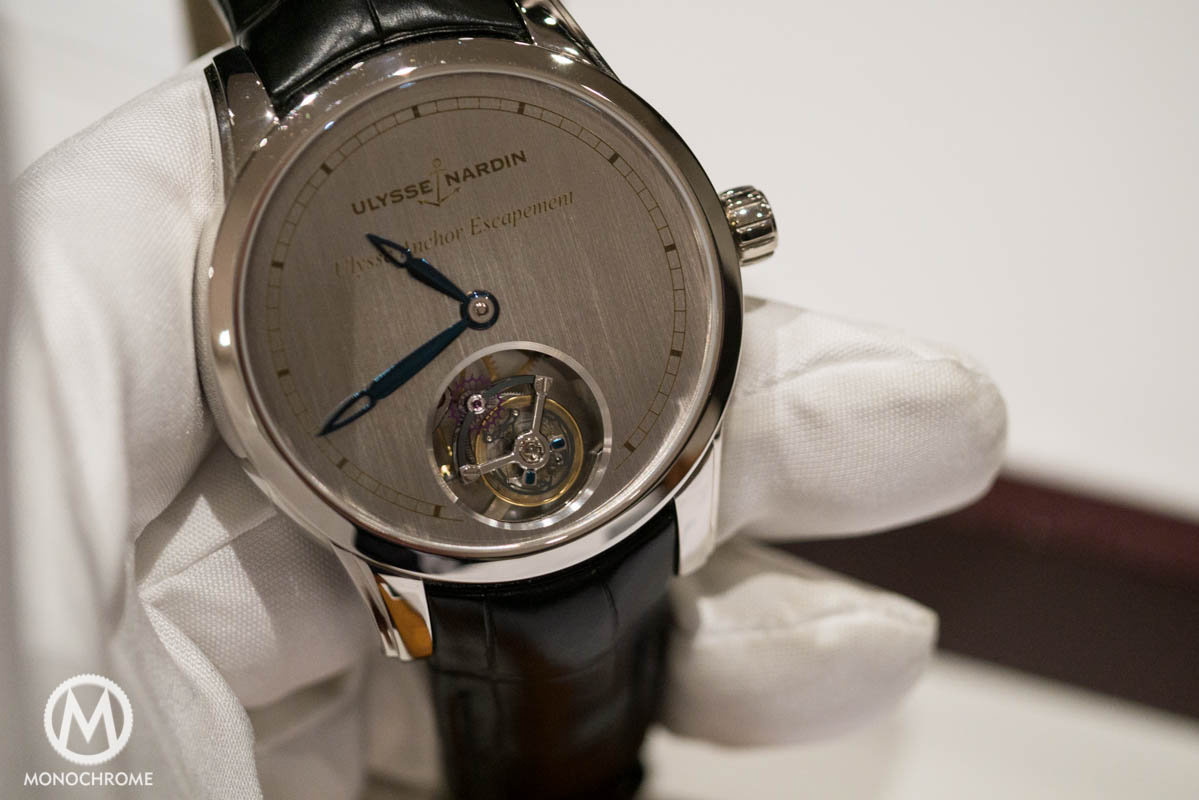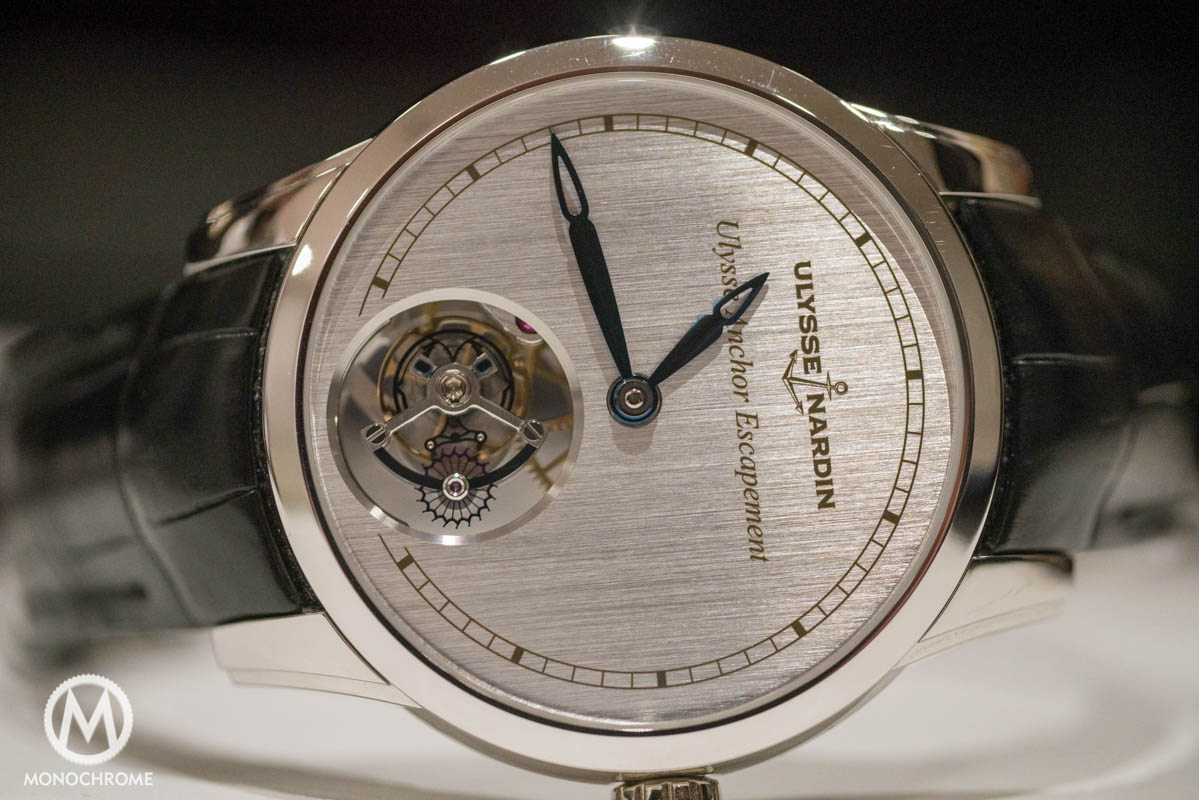Introducing the Ulysse Anchor Escapement

Earlier this year at Baselworld, Ulysse Nardin introduced an entirely new escapement that is referred to as the Ulysse Anchor Escapement. While its name does not immediately give away what it’s all about, it can best be seen in relation to previous ground-breaking developments of the brand, who were the first to introduce a silicon escapement wheel, and for that matter silicon in a wrist watch movement. That was with the introduction of the Freak, back in 2001.
Fast forward to the December 2012, when Monochrome broke the story of Girard-Perregaux’s new silicon escapement (and we’re not just talking about the escape wheel or pallet fork, but about the entire escapement) we immediately recognized the potential game-changing qualities. Ulysse Nardin’s new Ulysse Anchor Escapement works in more or less a similar way, and we believe it holds equal, or more, game-changing properties. Let us explain what the new escapement actually is, and why it is, potentially, such a game-changer.

In 2001 Ulysse Nardin introduced the Freak. A wrist watch that shocked the watch industry in more than one way. Its rather unusual design was probably the least shocking aspect. The technical design on the other hand, something that sprouted from the genius mind of Ludwig Oechslin, was nothing short of brilliant (the rotation of the Freak’s carrousel tourbillon movement is used to indicate the time.) However there was a third aspect that was, at the time, enough for a lot of commotion. The Freak’s escape wheel was made in silicon and to many silicon was not a material that belonged in the world of high-end watchmaking.
The late Rolf Schneider, Ulysse Nardin’s CEO, set up Sigatec, which is now one of the biggest suppliers of silicon components in the industry. A new technology like the Ulysse Anchor Escapement is not developed overnight and Ulysse Nardin and Sigatec have worked on it for seven years. That is seven years of research, developments and further improvements. This year they are ready to officially introduce show their new escapement, which is, in their own words, “a paradigm change in the approach to mechanical watchmaking.”

Like Girard-Perregaux’s Constant Escapement, the Ulysse Nardin Anchor Escapement is made of silicon and relies on the flexible properties of this material. But let’s take a step back and compare it to the traditional Swiss lever escapement that is used in pretty much every mechanical movement of the last century.
Let’s first have a look at what silicon is, and what properties made that many watch companies to chose to use it for the most fragile parts – the regulating parts – of the movement. While we always talk about silicon, it’s actually silicium and not the material used for ahum, female body enhancements. Silicium is hard, light, not sensitive to magnetism (thus anti-magnetic), and it doesn’t require any lubrication. Especially in the regulating organ the need for these properties is the highest, and therefore silicium is being mainly used for parts of the escapement. And maybe the most important factor is that silicium can be produced to an extreme precision, making it very eligible for the escapement components.
While the traditional principle of the Swiss lever escapement uses a balance wheel, an escapement wheel and a lever with pallets. The new Anchor Escapement features a circular silicon frame in which the pallet arms are suspended by two buckled blades that are – curved under tension – one perpendicular to the other. It relies on the physical properties of of blade springs to bend along one axis, while remaining perfectly rigid along other axis. This reproduces the kinetic function of a pivot.

Not only the used material, but also the principle of the buckling blades to control every impulse to the balance wheel is similar to Girard-Perregaux’s Constant Escapement that was invented by Nicolas Dehon (whom we interviewed last year.) The Constant Escapement comprises a blade that is fitted in a rather large framework that arches across the balance and escape wheel. In Ulysse Nardin’s solution the blades are part of a compact frame that is fitted on top of the balance wheel. In fact, it looks like the Anchor Escapement can replace an ordinary Swiss lever escapement without dramatic changes to the rest of the movement, and that makes it much easier in application.

The impulse, given at each semi-oscilation of the balance, transmits its energy to the blades, which snaps from one stable state to another, very much like a snap hair clip. The pallet arms, here without a pallet staff, thus pivot from side to side without generation friction. In fact, when it returns to its original position, it gives back its stored energy with virtually no loss! Last but not least, this construction needs no bridge for the pallet lever, allows for a slimmer movement.
Resuming:
- no need for lubrications (there’s no friction of materials that requires lubrication, hence no need for service)
- a slimmer movement
- less loss of energy (and possibly this leads to a longer power reserve)
- anti magnetic properties
…and probably more benefits that will be come clear when the Anchor Escapement becomes available in the collection. Purist will always prefer a mechanical movement without silicon. And that’s totally understandable. I woudn’t want to see a Voutilainen Vingt-8 or an A. Lange & Söhne Datograph with a silicon escapement. However for the vast majority of mechanical watches the advantages with outweigh the “purist preferences.”
Ulysse Nardin will introduce the first timepiece(s) with the Anchor Escapement at Baselworld 2015. The timepiece shown here is just a showcase for the Anchor Escapement, that is applied in a tourbillon (yes, that’s an option too!) Would it be to early to call the Ulysse Anchor Escapement brilliant? I don’t think so.
More info: www.ulysse-nardin.com







4 responses
The mechanism for this and the GP constant escapement are very similar and ingenious but may suffer from one issue not addressed so far: material fatigue. All materials fatigue and silicon blade that is snapping back and forth will eventually give out and fracture. My question is when? 1 yr or 10 years?
Great article! Do the buckling blades remove the sliding friction that is found in the lever escapement? Regarding the terminology – silicium is the French word for silicon. They are the same thing. Silicium was also used as an early name for the element in the English language. Silicone is an entirely different material.
JSD: Silicon exhibits material fatigue differently than metals. Generally, fatigue will only occur in silicon near the yield strength. This means that the material will either break, or not, as it is very brittle. As long as the stresses applied are below the yield strength level, the silicon part should last indefinitely. This is my general understanding, and I could be wrong. I welcome any contrary points!
You ought to know who Ulysses Bretling is!